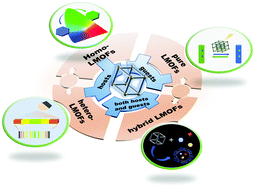Recent advances in luminescent metal–organic frameworks and their photonic applications
Abstract
In recent years, metal–organic frameworks (MOFs) have been attracting ever more interest owing to their fascinating structures and widespread applications. Among the optoelectronic materials, luminescent MOFs (LMOFs) have become one of the most attractive candidates in the fields of optics and photonics thanks to the unique characteristics of their frameworks. Luminescence from MOFs can originate from either the frameworks, mainly including organic linkers and metal ions, or the encapsulated guests, such as dyes, perovskites, and carbon dots. Here, we systematically review the recent progress in LMOFs, with an emphasis on the relationships between their structures and emission behaviour. On this basis, we comprehensively discuss the research progress and applications of multicolour emission from homogeneous and heterogeneous structures, host–guest hybrid lasers, and pure MOF lasers based on optically excited LMOFs in the field of micro/nanophotonics. We also highlight recent developments in other types of luminescence, such as electroluminescence and chemiluminescence, from LMOFs. Future perspectives and challenges for LMOFs are provided to give an outlook of this emerging field. We anticipate that this article will promote the development of MOF-based functional materials with desired performance towards robust optoelectronic applications.

- This article is part of the themed collection: 10th Anniversary of the Youth Innovation Promotion Association of the Chinese Academy of Science


 Please wait while we load your content...
Please wait while we load your content...